The high protein powders market is projected to expand from USD 27 billion in 2025 to USD 49.6 billion by 2035, at a CAGR of 6.3%, with regional growth driven by fitness system development, modernization of wellness operations, and the widespread use of performance nutrition across diverse consumer groups. North America remains the leading region, driven by extensive fitness ecosystems, large-scale sports nutrition programs, and high adoption of isolate and hydrolysate formulations that support advanced training and clinical recovery needs. The USA’s 6.4% CAGR reflects sustained protein integration in gyms, sports academies, and wellness facilities that prioritize purity-focused formulations and targeted nutrition protocols. Europe maintains steady expansion through modernization cycles in Germany, France, and the United Kingdom, where protein powders are integrated into structured fitness networks and regulated clinical nutrition frameworks. Established processing standards, strong adoption of flavor systems, and a shift toward premium isolate-based formulations reinforce regional momentum. Countries such as France and Germany are posting CAGRs of 6.5–5.7%, supported by ongoing upgrades to wellness platforms and precision-nutrition applications.
South Asia & Pacific emerges as the highest-growth region, led by India at 6.6% CAGR and China at 6.2% CAGR, where the expansion of fitness culture, sports development programs, and the rapid commercialization of plant-based systems are driving protein adoption across gyms, wellness chains, and modern retail channels. Technology integration in processing, diversified plant-based formulations, and rising consumer willingness to invest in high-performance protein solutions strengthen regional demand. Growth in East Asia, including South Korea and Japan, is steady, driven by precision nutrition, premiumization trends, and the modernization of wellness infrastructure. Latin America and the Middle East & Africa expand gradually, supported by increased accessibility to fitness facilities and early-stage wellness adoption.

| Metric | Value |
|---|---|
| Market Value (2025) | USD 27 billion |
| Market Forecast Value (2035) | USD 49.6 billion |
| Forecast CAGR (2025 to 2035) | 6.3% |
Animal-based proteins account for 55% of the market due to compatibility with standard fitness equipment and established bioavailability characteristics. However, adoption of plant-based proteins is increasing in applications where allergen resistance, dietary compliance, and sustainability are prioritized, particularly in wellness environments where traditional protein limitations lead to high dietary restriction costs.
Advances in protein processing, amino acid profiling, and flavor enhancement are improving absorption rates and taste reliability. Regionally, North America leads growth, with USA (6.4% CAGR) and India (6.6% CAGR) driven by fitness expansion and wellness investment, while more mature markets such as Germany, France, the United Kingdom, and China show steady replacement-driven demand tied to modernization and product upgrading cycles.
The high protein powders market grows by enabling fitness enthusiasts and health-conscious consumers to optimize their nutritional intake while accessing high-quality protein sources without substantial meal preparation investment. Athletes and recreational users face mounting pressure to achieve performance goals and maintain muscle mass while managing busy lifestyles and dietary restrictions. The nutrition industry's need for convenient protein delivery and application-specific formulations creates demand for comprehensive protein powder solutions that can provide superior absorption rates, maintain consistent quality standards, and ensure reliable performance without compromising taste preferences or dietary compliance.
Government initiatives promoting sports development and wellness programs drive adoption in fitness centers, clinical nutrition, and consumer applications, where protein quality has a direct impact on training outcomes and long-term health effectiveness. However, allergen management concerns during large-scale manufacturing processes and the expertise requirements for advanced formulation development may limit accessibility among smaller supplement companies and developing regions with limited regulatory infrastructure for protein quality assurance.
The market is segmented by source, formulation type, end use, product claim, flavor, distribution channel, consumer group, and region. By source, the market is divided into animal-based proteins such as whey protein, casein protein, egg protein, and collagen protein; plant-based proteins including soy, pea, rice, hemp, pumpkin seed, chickpea, and algae protein; and blended formulations combining both animal and plant-derived sources. Based on formulation type, the market is categorized into isolates, concentrates, hydrolysates, and blends that combine all three forms for enhanced amino acid balance and absorption.
By end use, the market is segmented into sports nutrition, clinical nutrition, weight management, infant nutrition, geriatric nutrition, and general wellness applications. In terms of product claim, the market is divided into non-GMO, organic, grass-fed (animal source), sugar-free, gluten-free, keto-friendly, and high BCAA content formulations catering to diverse dietary preferences. By flavor, the market is categorized into chocolate, vanilla, berry, coffee, unflavored, and other varieties such as cookies & cream, banana, and mocha.
Based on distribution channel, the the market is segmented into online retail, supermarkets and hypermarkets, specialty stores, pharmacies, and B2B channels such as private label and industrial use. By consumer group, the market is classified into athletes and bodybuilders, active lifestyle consumers, children, the elderly, and patients relying on medical nutrition. Regionally, the market spans North America, Europe, East Asia, South Asia & Pacific, Latin America, and the Middle East & Africa.
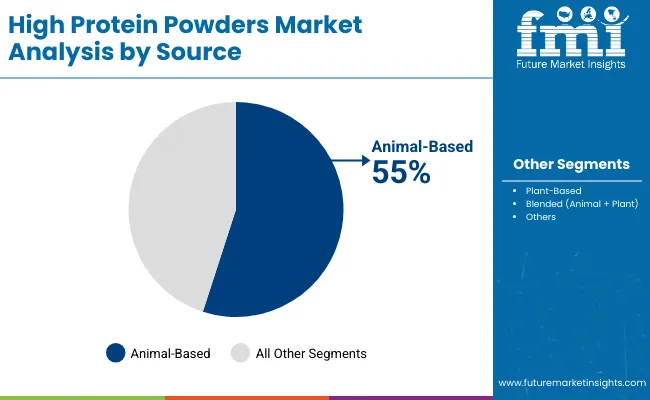
The animal-based segment represents the dominant force in the high protein powders market, capturing approximately 55% market share in 2025. This established source category encompasses solutions featuring advanced amino acid profiles and complete protein applications, including high-performance whey proteins and enhanced digestibility characteristics that enable superior nutritional benefits and training outcomes across all fitness applications. The animal-based segment's market leadership stems from its proven bioavailability capabilities, with solutions capable of addressing diverse performance requirements while maintaining consistent quality standards and absorption effectiveness across all training environments.
The plant-based segment maintains a substantial 38% market share, serving applications that require specialized allergen-free protein systems with enhanced digestibility properties for health-conscious and dietary-restricted applications. These solutions offer advanced nutritional capabilities for complex dietary requirements while providing sufficient protein characteristics to meet fitness and wellness operational demands. The blended segment accounts for approximately 7% of the market, serving specialized applications requiring specific performance properties or customized nutritional configurations.
Key source advantages driving the animal-based segment include:
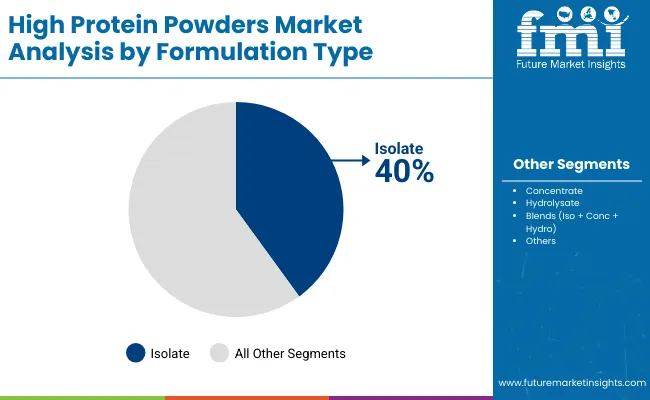
Isolate formulations dominate the high protein powders market with approximately 40% market share in 2025, reflecting the critical role of protein purity in supporting specialized fitness requirements and performance outcomes worldwide. The isolate segment's market leadership is reinforced by increasing training trends, purity requirements, and rising needs for fast-acting protein capabilities in sports applications across developed and emerging markets.
The concentrate segment represents the second-largest formulation category, capturing 35% market share through specialized requirements for cost-effective protein solutions, balanced nutritional profiles, and general fitness applications. This segment benefits from growing mainstream adoption demand that requires specific protein concentration levels, value positioning, and performance optimization protocols in fitness markets.
The hydrolysate segment accounts for 15% market share, while blends capture 10%, serving diverse performance and specialty applications across various fitness sectors.
Key market dynamics supporting formulation growth include:
The market is driven by three concrete demand factors tied to fitness and wellness outcomes. First, advanced sports nutrition development and personalized fitness solutions create increasing demand for high-quality protein powder systems. Second, government initiatives promoting health and fitness programs and wellness development drive increased adoption of protein powder systems, with many countries implementing sports development programs and regulatory frameworks for nutritional advancement by 2030. Third, technological advancements in plant-based processing and specialized formulations enable more effective and diverse protein solutions that improve training performance while reducing dietary restrictions and formulation complexity.
Market restraints include complex allergen management requirements and validation costs for protein powder platforms that can challenge market participants in developing compliant formulation capabilities, particularly in regions where regulatory pathways for advanced protein technologies remain evolving and uncertain. Technical complexity of protein processing systems and purity requirements pose another significant challenge, as protein powders demand sophisticated manufacturing methods and quality controls, potentially affecting production costs and operational efficiency. Raw material price volatility from agricultural commodity markets across different protein sources creates additional operational challenges for manufacturers, demanding ongoing investment in supply chain diversification and cost optimization programs.
Key trends indicate accelerated adoption in South Asia-Pacific markets, particularly India and China, where fitness culture expansion and wellness modernization drive comprehensive protein powder adoption. Technology integration trends toward specialized plant-based systems with enhanced amino acid characteristics, advanced flavor applications, and integrated performance solutions enable effective nutritional approaches that optimize training efficiency and minimize dietary risks. However, the market thesis could face disruption if significant advances in alternative protein technologies or major changes in fitness nutrition practices reduce reliance on traditional protein powder applications.

| Countries | CAGR (%) |
|---|---|
| India | 6.6 |
| China | 6.2 |
| Germany | 5.7 |
| France | 6.5 |
| UK | 5.5 |
| USA | 6. 4 |
| Brazil | 2.0 |
The global high protein powders market is expanding steadily, with India leading at a 6.6% CAGR through 2035, driven by fitness culture growth, government wellness initiatives, and advanced sports nutrition platforms. USA follows at 6.4%, supported by established fitness infrastructure, large-scale wellness programs, and sports nutrition development initiatives. France records 6.5%, reflecting growing integration in fitness applications and wellness manufacturing. China grows at 6.2%, anchored by wellness modernization and performance nutrition capabilities. Germany advances at 5.7%, leveraging advanced manufacturing and fitness applications. UK posts 5.5%, focusing on wellness integration, while Brazil grows steadily at 2.0%, emphasizing fitness accessibility and wellness development.
India demonstrates the strongest growth potential in the high protein powders market with a CAGR of 6.6% through 2035. The country's leadership position stems from fitness sector expansion, government-backed wellness initiatives, and comprehensive sports nutrition regulations driving the adoption of advanced protein powder solutions. Growth is concentrated in major urban and fitness centers, including Mumbai, Delhi, Bangalore, and Hyderabad, where fitness facilities and wellness companies are implementing advanced protein systems for enhanced training capabilities and nutritional efficiency.
Distribution channels through fitness retailers and wellness providers expand deployment across training projects and wellness development initiatives. The country's Ministry of Youth Affairs and Sports provides policy support for fitness technology modernization, including comprehensive nutritional capability development.
Key market factors:
In major urban and fitness centers including Beijing, Shanghai, Shenzhen, and Guangzhou, the adoption of comprehensive protein powder solutions is accelerating across wellness projects and fitness development initiatives, driven by wellness scaling and government health programs. The market demonstrates strong growth momentum with a CAGR of 6.2% through 2035, linked to comprehensive fitness modernization and increasing focus on nutritional efficiency solutions.
Chinese companies are implementing advanced protein powder systems and wellness platforms to enhance training performance while meeting growing demand in expanding sports nutrition and fitness manufacturing sectors. The country's health development initiatives create continued demand for nutrition equipment, while increasing emphasis on innovation drives adoption of advanced protein systems.
Key development areas:
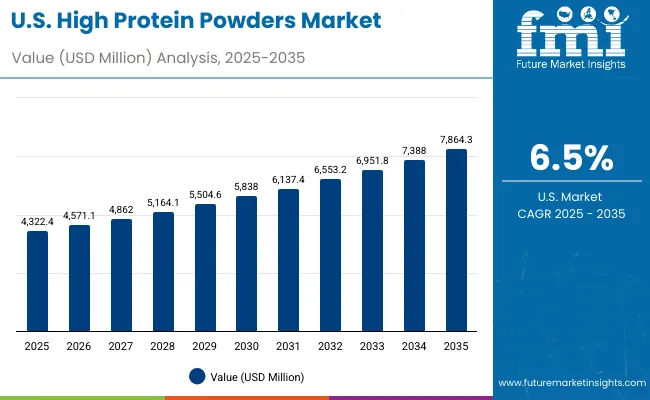
USA's market expansion is driven by diverse fitness demand, including sports nutrition manufacturing development in major cities and comprehensive wellness projects across multiple regions. The country demonstrates strong growth potential with a CAGR of 6.4% through 2035, supported by federal wellness programs and industry-level fitness development initiatives.
American companies face implementation challenges related to system complexity and scaling requirements, requiring strategic development approaches and support from specialized nutrition partners. However, growing fitness demands and advanced wellness requirements create compelling business cases for protein powder adoption, particularly in sports nutrition areas where advanced nutritional control has a direct impact on operational success and competitive positioning.
Market characteristics:
The Germany market leads in advanced processing innovation based on integration with fitness systems and precision nutrition technologies for enhanced quality performance. The country shows strong potential with a CAGR of 5.7% through 2035, driven by the modernization of existing fitness infrastructure and the expansion of advanced wellness facilities in major industrial areas, including Bavaria, Baden-Württemberg, North Rhine-Westphalia, and Lower Saxony.
German companies are adopting intelligent protein powder systems for quality improvement and efficiency enhancement, particularly in regions with advanced fitness requirements and wellness applications demanding comprehensive technology upgrades. Technology deployment channels through established fitness institutions and wellness operators expand coverage across training facilities and innovation-focused applications.
Leading market segments:
In Seoul, Daejeon, Busan, and other major cities, fitness facilities are implementing comprehensive protein powder solutions to modernize existing wellness infrastructure and improve training capabilities, with documented case studies showing a 50% improvement in nutritional timelines through advanced protein system integration. The market shows strong growth potential with a CAGR of 6.1% through 2035, linked to the ongoing modernization of fitness facilities, wellness networks, and emerging sports nutrition projects in major regions.
Korean companies are adopting intelligent protein and processing platforms to enhance fitness reliability while maintaining standards demanded by the sports nutrition and wellness industries. The country's established technology infrastructure creates continued demand for protein system development and modernization solutions that integrate with existing fitness systems.
Market development factors:
Japan's high protein powders market demonstrates advanced implementation focused on processing precision and nutritional performance optimization, with documented integration of precision protein systems, achieving 40% improvement in processing efficiency across fitness and wellness facilities. The country maintains steady growth momentum with a CAGR of 5.9% through 2035, driven by fitness facilities' emphasis on quality excellence and continuous operational methodologies that align with Japanese wellness standards applied to protein operations. Major fitness areas, including Kanto, Kansai, Chubu, and Kyushu, showcase advanced deployment of protein platforms where nutrition systems integrate seamlessly with existing fitness infrastructure and comprehensive quality management programs.
In Japan, the animal-based source segment dominates with 60.0% market share, supported by plant-based systems at 35.0% and blended technologies at 5.0%, reflecting the country's emphasis on precision nutrition and quality-focused fitness processes.
Key market characteristics:
France's high protein powders market demonstrates established and technology-focused landscape, characterized by growing integration of protein systems with existing fitness infrastructure across wellness projects, training networks, and modernization initiatives. France's emphasis on fitness excellence and nutrition innovation drives demand for advanced protein solutions that support comprehensive wellness initiatives and training requirements in fitness operations.
The market benefits from partnerships between international nutrition providers and domestic fitness leaders, creating service ecosystems that prioritize training excellence and wellness programs. Fitness centers in major regions showcase developing protein system implementations where nutrition systems achieve efficiency improvements through integrated wellness programs.
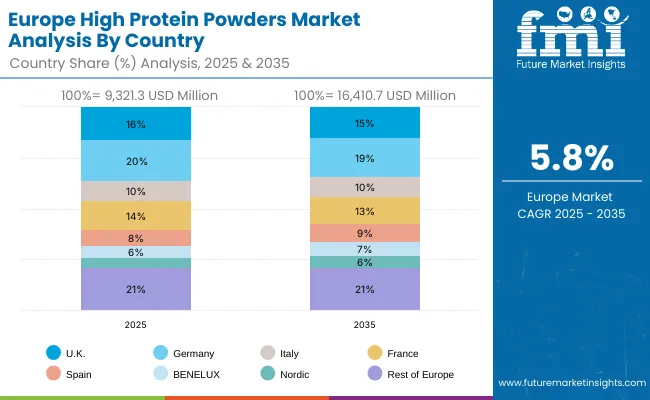
The high protein powders market in Europe is projected to grow from USD 9.3 billion in 2025 to USD 16.4 billion by 2035, registering a CAGR of 5.8% over the forecast period. Germany is expected to maintain its leadership position with a 20.0% market share in 2025, projected to reach USD 3.1 billion by 2035, supported by its extensive fitness infrastructure, advanced wellness facilities, and comprehensive training networks serving major European markets.
United Kingdom follows with a 16% share in 2025, projected to reach USD 2.4 billion by 2035, driven by comprehensive sports nutrition programs in major fitness regions implementing advanced protein systems. France holds a 14% share in 2025, expected to reach USD 2.2 billion by 2035 through the ongoing development of wellness facilities and training networks. Italy commands a 10% share projected to reach USD 1.6 billion, while Spain accounts for 8% expected to reach USD 1.4 billion. The Rest of Europe region is anticipated to maintain momentum, reaching USD 3.4 billion, attributed to increasing protein system adoption in Nordic countries and emerging Eastern European fitness facilities implementing wellness programs.
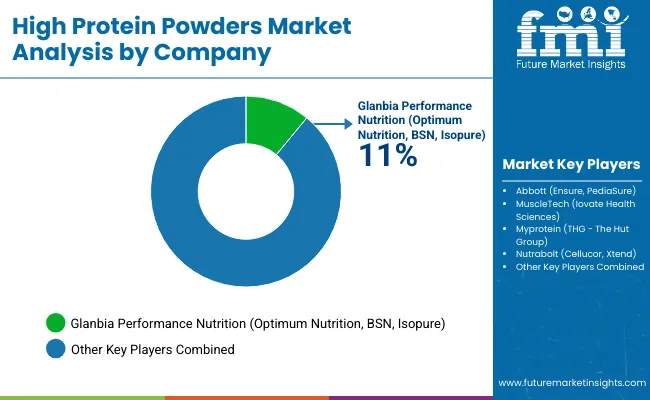
The high protein powders market features approximately 20-25 meaningful players with moderate concentration, where the top three companies control roughly 25-35% of global market share through established product portfolios and extensive distribution relationships. Competition centers on protein quality, formulation innovation, and brand reputation rather than price competition alone.
Market leaders include Glanbia Performance Nutrition (Optimum Nutrition, BSN, Isopure), Abbott (Ensure, PediaSure), and MuscleTech (Iovate Health Sciences), which maintain competitive advantages through comprehensive protein product portfolios, advanced processing capabilities, and deep expertise in the sports nutrition and clinical sectors, creating high switching costs for customers. These companies leverage established distribution relationships and ongoing research partnerships to defend market positions while expanding into adjacent wellness and clinical applications.
Challengers encompass Myprotein (THG - The Hut Group) and Nutrabolt (Cellucor, Xtend), which compete through specialized protein technologies and strong direct-to-consumer presence in key fitness markets. Fitness specialists, including Quest Nutrition, NOW Foods, and Body Fortress, focus on specific protein applications or vertical markets, offering differentiated capabilities in clean-label systems, specialized formulations, and application-specific processing.
Regional players and emerging nutrition companies create competitive pressure through innovative protein approaches and rapid development capabilities, particularly in high-growth markets including India and China, where local presence provides advantages in cost optimization and regulatory compliance. Market dynamics favor companies that combine advanced protein technologies with comprehensive fitness services that address the complete nutrition lifecycle from formulation through ongoing performance assurance and customer support.
| Items | Values |
|---|---|
| Quantitative Units (2025) | USD 27 billion |
| Source | Animal-Based, Plant-Based, Blended (Animal + Plant) |
| Formulation Type | Isolate, Concentrate, Hydrolysate, Blends (Isolate + Concentrate + Hydrolysate) |
| End Use | Sports Nutrition, Clinical Nutrition, Weight Management, Infant Nutrition, Geriatric Nutrition, General Wellness |
| Product Claim | Non-GMO, Organic, Grass-Fed (Animal Source), Sugar-Free, Gluten-Free, Keto-Friendly, High BCAA Content |
| Flavor | Chocolate, Vanilla, Berry, Coffee, Unflavored, Others (Cookies & Cream, Banana, Mocha, etc.) |
| Distribution Channel | Online Retail, Supermarkets/Hypermarkets, Specialty Stores, Pharmacies, B2B (Private Label, Industrial Use) |
| Consumer Group | Athletes & Bodybuilders, Active Lifestyle Consumers, Children, Elderly, Patients (Medical Nutrition) |
| Regions Covered | North America, Europe, East Asia, South Asia & Pacific, Latin America, Middle East & Africa |
| Countries Covered | India, China, USA, Germany, France, UK, Brazil, South Korea, Japan, and 40+ countries |
| Key Companies Profiled | Glanbia Performance Nutrition, Abbott, MuscleTech, Myprotein, Nutrabolt |
| Additional Attributes | Dollar sales by source and formulation categories, regional adoption trends across North America, Europe, and South Asia & Pacific, competitive landscape with nutrition providers and fitness companies, processing facility requirements and specifications, integration with wellness initiatives and fitness platforms. |
The high protein powders market is valued at USD 27.0 billion in 2025.
The market is forecast to reach USD 49.6 billion by 2035.
The market is expected to grow at a CAGR of 6.3% over 2025-2035.
Animal-based proteins account for about 55% of total high protein powder demand in 2025.
Plant-based protein powders hold around 38% share and are gaining traction in allergen-sensitive, vegan, and sustainability-focused consumer groups.
Sports nutrition is the largest application, accounting for roughly 45% of demand in 2025.






Our Research Products

The "Full Research Suite" delivers actionable market intel, deep dives on markets or technologies, so clients act faster, cut risk, and unlock growth.

The Leaderboard benchmarks and ranks top vendors, classifying them as Established Leaders, Leading Challengers, or Disruptors & Challengers.

Locates where complements amplify value and substitutes erode it, forecasting net impact by horizon

We deliver granular, decision-grade intel: market sizing, 5-year forecasts, pricing, adoption, usage, revenue, and operational KPIs—plus competitor tracking, regulation, and value chains—across 60 countries broadly.

Spot the shifts before they hit your P&L. We track inflection points, adoption curves, pricing moves, and ecosystem plays to show where demand is heading, why it is changing, and what to do next across high-growth markets and disruptive tech

Real-time reads of user behavior. We track shifting priorities, perceptions of today’s and next-gen services, and provider experience, then pace how fast tech moves from trial to adoption, blending buyer, consumer, and channel inputs with social signals (#WhySwitch, #UX).

Partner with our analyst team to build a custom report designed around your business priorities. From analysing market trends to assessing competitors or crafting bespoke datasets, we tailor insights to your needs.
Supplier Intelligence
Discovery & Profiling
Capacity & Footprint
Performance & Risk
Compliance & Governance
Commercial Readiness
Who Supplies Whom
Scorecards & Shortlists
Playbooks & Docs
Category Intelligence
Definition & Scope
Demand & Use Cases
Cost Drivers
Market Structure
Supply Chain Map
Trade & Policy
Operating Norms
Deliverables
Buyer Intelligence
Account Basics
Spend & Scope
Procurement Model
Vendor Requirements
Terms & Policies
Entry Strategy
Pain Points & Triggers
Outputs
Pricing Analysis
Benchmarks
Trends
Should-Cost
Indexation
Landed Cost
Commercial Terms
Deliverables
Brand Analysis
Positioning & Value Prop
Share & Presence
Customer Evidence
Go-to-Market
Digital & Reputation
Compliance & Trust
KPIs & Gaps
Outputs
Full Research Suite comprises of:
Market outlook & trends analysis
Interviews & case studies
Strategic recommendations
Vendor profiles & capabilities analysis
5-year forecasts
8 regions and 60+ country-level data splits
Market segment data splits
12 months of continuous data updates
DELIVERED AS:
PDF EXCEL ONLINE
High Purity Gas Flow Meter Market Size and Share Forecast Outlook 2025 to 2035
High Purity Flow Meter Market Size and Share Forecast Outlook 2025 to 2035
High Performance Permanent Magnet Market Size and Share Forecast Outlook 2025 to 2035
High Airtight Storage Cabinets Market Size and Share Forecast Outlook 2025 to 2035
High Voltage Porcelain Bushing Market Size and Share Forecast Outlook 2025 to 2035
High Purity Process Systems for Semiconductor Market Size and Share Forecast Outlook 2025 to 2035
High Octane Racing Fuel Market Size and Share Forecast Outlook 2025 to 2035
High Voltage Air-cooled Battery Compartment Market Size and Share Forecast Outlook 2025 to 2035
High Temperature NiMH Battery Market Size and Share Forecast Outlook 2025 to 2035
High Current Power Supply for Electrophoresis Market Size and Share Forecast Outlook 2025 to 2035
High Voltage Cable Termination Market Size and Share Forecast Outlook 2025 to 2035
High Security Wedge Barricades Market Size and Share Forecast Outlook 2025 to 2035
High Purity Chemical Filters Market Size and Share Forecast Outlook 2025 to 2035
High Performance Liquid Chromatography-Tandem Mass Spectrometry System Market Size and Share Forecast Outlook 2025 to 2035
High-vacuum Fiber Feedthrough Flanges Market Size and Share Forecast Outlook 2025 to 2035
High Pressure Grease Hose Market Size and Share Forecast Outlook 2025 to 2035
High Performing Matting Agent Market Size and Share Forecast Outlook 2025 to 2035
High Reliability Oscillators Market Size and Share Forecast Outlook 2025 to 2035
High-performance Dual-core Processor Market Size and Share Forecast Outlook 2025 to 2035
High Purity Magnesium Citrate Market Size and Share Forecast Outlook 2025 to 2035

Thank you!
You will receive an email from our Business Development Manager. Please be sure to check your SPAM/JUNK folder too.
Chat With
MaRIA